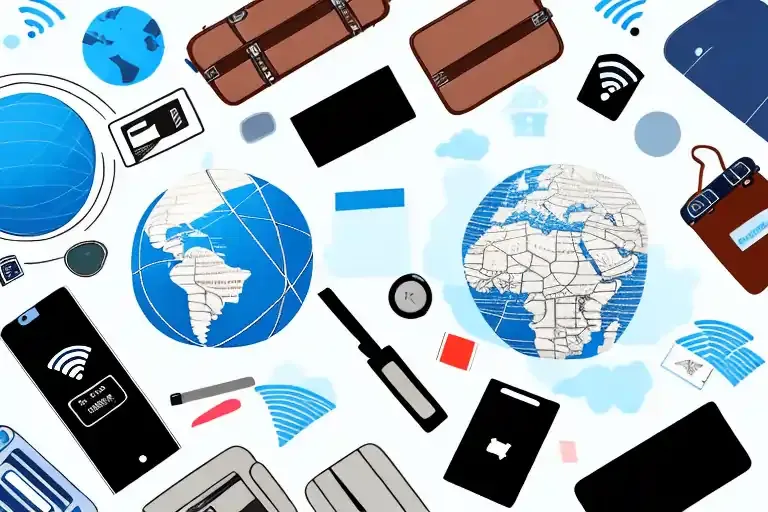eSIM
Is it worth it to get a travel eSIM?
Compare 3 factors to help you decide.
You might have probably seen your friends and families use an eSIM for their travels; or you might have been recommended to use one for your upcoming trip. If you are planning your next trip, and the thought of trying an eSIM has crossed your mind, you might be wondering if it is worth it to switch to a travel eSIM. In many cases, it’s your best bet to avoid roaming charges while staying connected effortlessly abroad.

Whether a switch to a travel eSIM is worth it ultimately depends on what you are comparing it against. Would it be better than your existing solution? What are the advantages and disadvantages? Let's take a look at some pros and cons to help you make an informed decision.
Highly rated 4.4/5.0 on Trustpilot
Save up to 50% on roaming
Fast and reliable network
Factor 1: Cost
The cost of getting a travel eSIM is probably one of the most important factors in helping you decide if a switch to a travel eSIM is worth it.
International Roaming vs Travel eSIM
- Travel eSIMs are almost always cheaper than if you were to switch on international roaming.
- However, if your existing telco or plan offers roaming packages, then do check what those plans entail. These packages can sometimes be cheaper; though these are usually more applicable for closer destinations.
Local SIM cards vs Travel eSIM
- Traditionally, local SIM cards are known to be the cheapest option to staying connected when traveling.
- But, this is not always the case as tourist plans can sometimes actually be more expensive than getting a travel eSIM - especially if the tourist plans include features that you might not actually need.
Portable WiFi vs Travel eSIM
- If we were to compare the prices, a portable WiFi rental could is typically more expensive than if you were to get a travel eSIM. The cost could add up especially for longer trips.
- But, if you will be traveling as a group, and all of you will be sharing the same portable WiFi, then it could add up to be cheaper than if you were to individually buy travel eSIMs.
- However, if your travel eSIM supports hotspot and tethering, then you might not need to get one travel eSIM for each traveler in your group. By sharing data from your travel eSIM, you could bring down the total cost.
Factor 2: Convenience
One of the biggest draw factors of eSIMs is the convenience that it promises. You no longer have to fumble with your physical SIM cards nor worry about losing the SIM cards. But, how does a travel eSIM compare to your existing way of staying connected?
International Roaming vs Travel eSIM
- International roaming is probably the most convenient option. After all, as long as your plan allows you to roam (or if you have a data roaming pass), you don't need to do anything else - just get to your destination, and you'll be connected!
- With travel eSIMs, you'll need to buy your plan and install it in your phone — it's not too difficult, but is a little less convenient compared to international roaming.
Local SIM cards vs Travel eSIM
- To get a local SIM card (or even a local eSIM), you often will need to queue at the counters at the airport or in shops. Getting a local SIM card or eSIM also usually requires that you provide your identity documents for KYC checks.
- With a travel eSIM, do away with the hassle of queuing at counters. Simply buy your travel eSIM online, even before you arrive at your destination! Travel eSIMs also usually doesn't require you to provide a proof of identity.
- If you will be traveling across multiple destinations, travel eSIMs are almost always the better option. Instead of getting multiple local SIM cards, you can get a regional travel eSIM to help you seamlessly stay connected as you move across different destinations.
Portable WiFi vs Travel eSIM
- Using a portable WiFi means you'll need to carry around an additional device, and that's also an additional device you will have to charge. It also means that your travel party will need to stick around together so all of you can use the portable WiFi.
- Your travel eSIM profile will be installed in your device. Don't worry about having to carry around additional devices; and you don't always have to travel as a group!
Factor 3: Features
Another factor to consider would be the features that are available with your various options. Travel eSIMs primarily offer data connectivity so you can access the internet as you travel, but do the other options provide any additional features that you might require?
International Roaming vs Travel eSIM
- International roaming and travel eSIMs do not differ much when comparing the features.
- International roaming allows you to make calls, send SMSes, and access the internet while you are overseas — just like you would at home. However, any calls you make or SMSes you send will be using your primary number and would incur roaming charges.
- Travel eSIMs typically do not come with calls or messages, so you won't be able to use your travel eSIM to make calls or messages. But, if you need to make calls or send messages, you can still do so using your primary line; roaming charges would be incurred depending on your plan and usage details.
Local SIM cards vs Travel eSIM
- Local SIM cards sometimes come with a local phone number that you can use to make calls or send messages at your destination.
- Travel eSIMs usually only include data connectivity, and do not come with a local phone number or local calls.
Portable WiFi vs Travel eSIM
- Both portable WiFi and travel eSIMs primarily offer data connectivity, without any call or messaging features.
- Portable WiFi allows multiple devices to be connected to it at the same time.
- Travel eSIMs that allow hotspot or tethering capability can also allow multiple devices to use the same eSIM plan — but do check the terms of your travel eSIM, as not all providers support tethering.
Get a Nomad eSIM for your next trip
All ready to embark on your travel eSIM journey? Get a travel eSIM from Nomad!
Nomad offers data plans in over 200 countries, and you can be sure to find one that is suitable for your travel needs. And if you will be traveling across multiple countries, there are also regional plans available so you can stay seamlessly connected as you hop between countries. Data plans are available from as low as $1.50/GB.
If you are unsure about how much data you need for your trip, Nomad also has a Data Calculator that can help you find the plan that is most suitable for you. Also check out our blog post on data-saving tips when traveling to keep your data usage in check when traveling.
Nomad also has a 24-hour customer support team. So, in the event where you face difficulties while using your eSIM, rest assured there will be someone available to help you resolve your issues!



